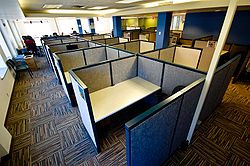- Office space planning
-
Office layouts are arranged so that staff can work together in departmental and team groupings, providing the best opportunity for efficient work flow, communication and supervision.
Contents
Churn rate
In many organisations, office layouts are subject to frequent changes. This process is referred to as churn rate,[1] expressed as the percentage of the staff moved during a year.
Statutory requirements
Statutory requirements related to office layouts will vary in different countries but examples may include: the minimum amount of space to be provided per staff member; fire safety arrangements;[2][3] lighting levels; signage;[4] ventilation; temperature control and welfare arrangements.[5]
Business needs
Office layout designs should provide an environment suitable for the business needs of the organisation. For example: call centres undertake their business ‘on screen’ and require small desk areas per staff member, minimum document storage, and may have limited requirements for photocopying facilities and printing. In contrast, companies handling paper based documentation will require larger desks for their staff, storage for records, archive facilities, photocopying and printing facilities close to hand.
Accommodation standards
Organizations often have a policy on the minimum standards of accommodation for each staff grade. Administration staff may work in open plan offices whereas mangers may have individual offices, sized on a seniority basis. In open plan offices screens are sometimes used between desks to reduce noise and provide an element of privacy.
Space planning
The grouping of staff in teams often provides the best option for inter-communication and/or supervision and is a key factor in office layout design. However, where space is at a premium it may be difficult to accommodate a workgroup in a given area, and the solution often involves making space by moving others. These types of move may be complex and disruptive as there is often a chain of events involved.
Planning tools – CAD
Modern office layouts are frequently planned using CAD (Computer-aided design) drawing software.[6]
Services
Each desk in an office may require a telephone and computer.[7] In large offices the power and data cables may be run under a raised floor to the desk. Another alternative in smaller offices is to use dado trunking around the wall. Other alternatives are to use ceiling power poles which can assist space planning of desks away from perimeter walls
Partitions
Open plan offices are often divided up into smaller offices for managers, meeting rooms, etc. When this happens the designer has to take into account several factors [8] including:
- Heating/cooling zoning
- Ventilation
- Lighting and light switches[9]
- Emergency lighting
- Small power
- Voice and data cabling
- Fire alarms
- Fire stopping
- Fire escape routes
- Noise/acoustics
Staff welfare facilities
Office staff require access to basic welfare facilities in an office such as toilets and drinking water. Consideration may also be given to vending, catering or a place where staff can make a drink and take a break from their desk.
References
- ^ Alexi Marmot, Joanna Eley; “Office space planning: designing for tomorrow's workplace” McGraw Hill P91
- ^ (UK) BS 9999:2008 Code of practice for fire safety in the design, management and use of buildings, British Standards Institution
- ^ [1] (UK) The Regulatory Reform (Fire Safety) Order 2005, Her Majesty's Stationery Office
- ^ [2] (UK) The Health and Safety (Safety Signs and Signals) Regulations 1996, Her Majesty's Stationery Office
- ^ [3](UK) The Workplace (Health, Safety and Welfare) Regulations 1992, Her Majesty's Stationery Office
- ^ BS 1192:2007 Collaborative production of architectural, engineering and construction information. Code of practice
- ^ [4] (UK) The Health and Safety (Display Screen Equipment) Regulations 1992, Her Majesty's Stationery Office
- ^ [5] (UK) Building Regulations - Part B Fire Safety Volume 2; Part M Access to and use of Buildings; Part E (Resistance to sound)
- ^ (UK) BS EN 12464-1:2002 Light and lighting. Lighting of work places. Indoor work places, British Standards Institution
Categories:
Wikimedia Foundation. 2010.

